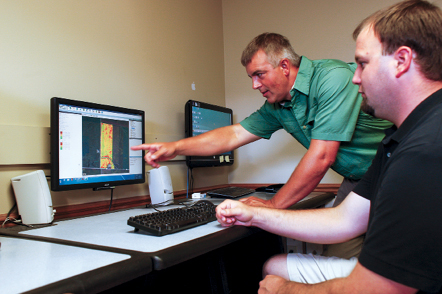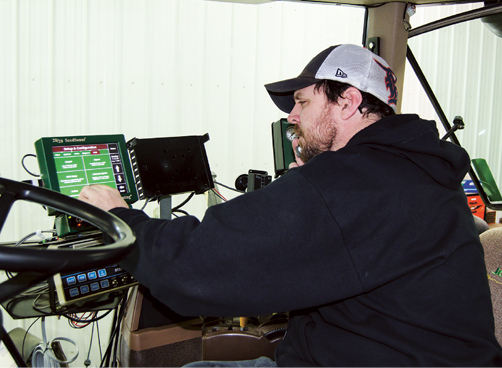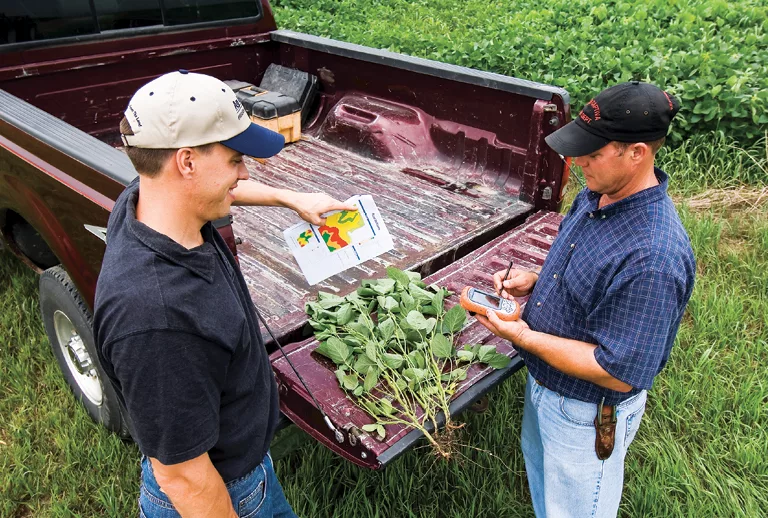Whether it’s at a conference booth, a nearby dealership or even the local coffee shop, talk about farm data is everywhere.
But when there’s talk of farm data, it’s usually about the many collection methods, type of collection equipment, valuable uses for and safety of that data. Little is said about making sure the data being vacuumed up from fields all over the country is accurate.
The precision farming equipment responsible for pulling planting, yield, input application and many other types of farm data are highly advanced, but they aren’t infallible.
To get the biggest benefit out of farm data it must be as precise as possible. But to ensure that level of quality, farmers have to configure, calibrate and validate it in the field.
Configuring Equipment
Collecting accurate data and using it to make farm management decisions is something Jeremy Wilson contends with professionally as the technology specialist at Crop IMS, a precision consulting company. But amassing fine-tuned data is also something he does personally on his 1,200-acre farm in Olney, Ill., where he no-tills corn, wheat and soybeans with his father, Wade. Wilson says that ideal data collection starts at the configuration stage.
“Whether it’s with planting, chemical application or harvest, one of the biggest issues we keep seeing is with missing or incorrect client, farm and field structure,” says Wilson. “During planting you have to make sure your hybrid and variety are selected, populated correctly and any other specifications like dual drive or split planting are punched in.”
Wilson notes that during fertilizer or other input applications, the process remains the same.
“Make sure to plug in the right products, use the right mixtures and confirm that they are entered correctly,” Wilson says. “During harvest, make sure to enter the right hybrids and varieties again if you don’t have automatic tracking.”

FIXATION ON CALIBRATION. Calibrating equipment once per season might be sufficient for a farmer’s needs, but depending on the goals he or she has with that farm data, more frequent calibrations may be in order. Grain types, wet or dry conditions and even variations in bushel count may all be a reason to recalibrate equipment mid-season for accurate data collection.
Although it seems fairly straightforward, Wilson feels there are still a large number of farmers that overlook some of these details.
“I’d say about 60-70% of us are now at least recording some type of farm data, but it’d be hard to say that more than 10% of farmers are really doing all that’s necessary to confirm they are collecting quality data,” he says.
Configuring data collection equipment is only the first step though. Confirming that it’s working properly is an important follow-up that is easily overlooked. Wilson says that depending on the type of data, validating it can be a 5-minute process that is well worth the extra time.
“It’s crucial to dig up a few kernels at planting and validate the population. Or when we’re fertilizing, we can watch a tank or two to make sure that the gallons per acre are being documented correctly,” Wilson says. “During harvest we can use a handheld moisture tester to see that the moisture readings are correct, and that we’re documenting the correct pounds harvested if we have access to a weigh wagon.
“It’s worth the effort. We only get one chance in a growing season to capture that data and do it right.”
Calibrating Frequently
Although many farmers aren’t anxious to add a new regularly scheduled maintenance item to their lists, making sure farm data-collection equipment is properly calibrated every season is becoming increasingly important. Kaleb Lindquist, software sales specialist with Ag Leader, says while it’s tempting to hit the field at the first good opportunity, time spent calibrating equipment can make the difference between useable and useless data.
“Taking the time to do pre-season work like making sure the display is set up correctly and the sensors are calibrated is valuable to the farmer,” Lindquist says. “A lot of different variables can affect the quality of the data. If we have garbage data coming in, we’re going to get garbage data out.”

Jeremy Wilson
“It’d be hard to say that more than 10% of farmers are really doing all that’s necessary to confirm they are collecting quality data…”
Calibrating equipment once per season might be sufficient for a farmer’s needs, but depending on the goals he or she has with that farm data, more frequent calibrations may be in order. Wilson says that adjusting for conditions that may affect sensor readings will get a farmer closer to quality data.
“On yield data there is a huge difference between grain types and wet or dry corn. These are variables that you’d want to consider recalibrating for,” he explains. “Also, if you see a big change in overall yield per acre — for instance, if we’ve been harvesting 170-180 bushels of corn calibrated and suddenly we’re around 120 bushels — it would be a good time to calibrate and validate that.”
The same holds true for planting, he says. Changing hybrids and grain size are good reasons to recalibrate and confirm population to ensure that the data is being captured correctly.
Aaron Ault, who works as a senior research engineer at Purdue University and as a project lead on the Open Ag Data Alliance, has been grappling with data quality for 20 years on his 3,000-acre farm in Rochester, Ind. On Ault’s farm, where he grows corn, soybeans and wheat while managing a 3,000-head beef cattle herd, he takes the approach that form should follow function in terms of how often a farmer should have data-collection equipment calibrated.
“The level of precision you need with your data is defined by the intended end-use of it,” Ault says. “If you need to find out whether corn or soybeans were planted in a given field during a given year, that data is simple. If you’re evaluating the performance of two different hybrids that have a $2-per-acre price difference, you’ll have to be able to register a 1-bushel-per-acre difference. That’s really hard to do reliably.”
Like Wilson, Ault says that calibrating equipment often will help cope with many different variables and provide more precise averages, but he cautions against setting expectations too high. Variations in moisture, varieties of corn and other harvesting conditions can all effect how accurate yield data is.
“If you’re harvesting 30% moisture corn and then you harvest 20% moisture corn, you need to calibrate once for each,” says Ault. “There is a whole continuum of variations to contend with.”

Aaron Ault
“The level of precision you need with your data is defined by the intended end-use of it…”
He explains that the scales themselves can be significantly affected by hillsides in the field, as the sensors tilt and gravity can have an effect on estimates. A grower might also have some variations if he has a huge amount of corn come in that doesn’t clean at first and runs through the rotor a second time.
“Every time that happens, nothing is compensating for the fact that the corn has been through the combine twice by the time it hits the yield sensor instead of once,” Ault says.
He notes that in many ways there is a tradeoff that takes place between data quality and logistics. To calibrate equipment often and constantly validate its accuracy, a farmer has to stop working off and on. Ault personally knows of a 30,000-acre farm — one of the largest in the country — that doesn’t use a single yield monitor in their operation.
“It’s largely because they can’t stop an operation that size and coordinate to have all those combines calibrated regularly,” Ault says. “That’s the reason a lot more people are not doing it, because it doesn’t fit their program. But if they aren’t using that data for anything very precise, it doesn’t matter anyway.”
Fine-tuning farm management decisions on smaller scales may be a bit easier though. Just how closely a farmer monitors incoming data should depend on the intended goal, Ault says.
“If the data is only accurate plus or minus 10% and we’re tracking a 200-bushel corn yield, that’d be off by 20 bushels per acre, which is pretty substantial,” he says. “Most people would agree that accuracy within 10% is still pretty good for yield data, but if one spot of the field did 5 bushels better per acre while everything is potentially off by 20, your data has essentially told you nothing of value.”
Organize and Categorize
Making sure the data coming in is as accurate as possible is crucial, but organizing, cataloging and backing it up can be equally so.
“We have to keep an orderly catalogue of our data and clearly define what it is,” Wilson says. “A perfect example was this spring. We had a service provider who was giving us some fertility recommendations and accidentally misplaced a few fields’ worth of data from 2014. Luckily, I have a great record of it backed up so I was able to retrieve it in 5 minutes.”
With new innovations, software and storage techniques constantly hitting the market, a hodgepodge filing system can quickly take shape. Wilson feels that migrating to the cloud will help prevent this — something he plans to start doing this spring.
The solution he will be moving to is the Agriculture Data Coalition, whose goal is to create a neutral, independent, farmer-centric data repository where farmers can securely store and control the information collected every day in the fields by their tractors, harvesters, aerial imaging and other devices.
Some equipment, such as Ag Leader’s displays, can upload data automatically, which can make keeping it in one place and organizing it a bit easier.

CORRECT CONFIGURATION. Missing or incorrect client, farm and field structure is a prevalent issue in data collection. Ensuring that correct hybrids, varieties, populations and a host of other variables are properly selected before data collection begins is a simple and important step toward collecting clean data.
“With our new displays you don’t have to mess with anything as far as exporting data,” Lindquist says. “It’s all being collected on the display and then it just syncs with our AgFiniti Mobile app at the end of the day if you want. There’s no chance of it getting lost or misinterpreted, and then you can sync it to SMS software as well.”
Josh Skanderup, product manager with Raven Industries, says that depending on the software used, some interfaces will actually help push a farmer to dig deeper for quality data in addition to organizing it.
“Importing your data to a software platform like MapShots or SST Software’s Sirrus app is great because most of those software programs force you to sort of fill in the data blanks,” he says. “Some may think that it’s opportunistic data — just getting a lot of data from wherever you can — and it might seem more like a hindrance than a benefit. But setting it up this way enforces the need for good data and helps organize it in a way that’s useable for the farmer and their service providers.”
With apps like Sirrus, prompts such as planting date, historical weather or crop-scouting details can help build and organize a fuller catalog of conditions that may be valuable at a later time.
Realistically Considering Data
After investing so much time and money into the quest for clean and accurate data, farmers hope to see a concrete utility and return on it. That said, an important part of collecting data and using it responsibly to aid in farm management is realizing its limitations.
“What concerns me is so many people feel confident that all their data is truly useable as a pool to benchmark from,” Lindquist says. “Even with great data coming in, there are some opportunities for misinterpretation industrywide regarding trends. Generally speaking, I think we can get a decent look at what’s going on, but when we start zeroing in on highly specific data sets, we have to be careful with the conclusions.”
Skanderup says that the data should perhaps be seen more as information to be used for guidance rather than direction.
“There are so many moving parts with farm data collection, and so many variables. We probably shouldn’t see our data pool as a silver bullet,” he says. “Instead of seeing a formula to follow the next year, we should look at it as valuable insight.”
Ault can remember times in the past when inaccurate data has lead him astray. He feels that data can often have the effect of making someone more confident rather than competent.
“Utilizing farm data is going to be a deciding factor on farms that succeed and farms that don’t in the future, but you can also make wrong decisions based off of data,” he says. “I’ve been doing this on my farm for 15-20 years and I started out with very coarse information. Over those years I’ve been getting cleaner data and validating more of my averages. I’ve found that I’ve drawn some incorrect conclusions from some flawed data in the past — we just have to be aware that it’s a possibility.”
Because 100% accurate and comprehensive farm data isn’t yet possible, Ault encourages farmers to use data to make broad strokes and correlate those with harder data to make the best judgements.
“Most farmers like to work with aggregate numbers and averages,” he says. “We like to look at financials at the end of the year and match up some big numbers and big categories. That, to me, is always the best way of testing the quality of your data and using it.
“You can take some numbers that are concrete like total dollars written out of the bank account for fertilizer and compare that to the total amount applied and use all the data together to make decisions.”






